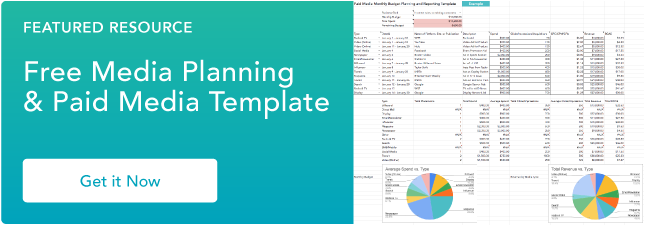I’m watching Kids Halloween Baking Championship on Hulu. There is a commercial break and I learn that I can get a low $199/mo lease on the newest Nissan Altima — all thanks to programmatic advertising.

Programmatic advertising is everywhere, from the podcasts you listen to daily to the videos you watch on YouTube. These ads also show up when you’re browsing social media sites, websites, magazines, and newspapers.
It’s a popular advertising method for brands — with good reason. Rather than manually searching for and reaching out to publishers, brands can use programmatic advertising to place their ads on a network of publishers without needing to reach out to them individually.
Let’s go over this popular method, how it works, and how you can get started with programmatic advertising. We'll cover:
- What is Programmatic Advertising?
- The Basics of Programmatic Marketing, Advertising, and Buying
- Benefits of Programmatic Advertising
- Disadvantages of Programmatic Advertising
- Types of Programmatic Ads
- Programmatic Ad Companies
- Programmatic Advertising Examples
What is Programmatic Advertising?
Programmatic advertising is the automated process of purchasing and selling online ads. The buying and selling of ad space happens in real-time through an automated system called a Demand Side Platform (DPS). This method gives advertisers the ability to place ads across multiple channels with little human interaction.
To better illustrate, let’s compare traditional advertising to programmatic advertising.
In traditional advertising, you would approach a publisher — a newspaper, a magazine, or a website owner — and ask for their media kit. Once you review the media kit, you’ll choose the option that best fits your budget. Your ad runs for a predetermined amount of time, and if you want to renew your contract, you have to reach out again to your account manager.
In programmatic advertising, all of this manual work is taken out of the equation. You create one ad, sign up on a programmatic ad platform, choose your target audience, and let the platform do the rest.
Local Programmatic Advertising
A subsect of programmatic advertising is local programmatic advertising. This type of advertising takes an even more granular approach to geo-targeting (also called geofencing) by partnering specifically with publications, radio stations, and TV channels in a particular geographical area.
When you launch a localized programmatic advertising campaign, your ad runs on publications owned by local media groups. These include news stations, local radio, and even newspapers.
Still confused? No worries. Below, we’ll walk you through the basic elements of programmatic advertising and give you an example of how it works.
The Basics of Programmatic Marketing, Advertising, and Buying
Programmatic advertising gives brands or agencies the ability to automatically bid on ad spaces on a wide variety of publications and channels. For example, a brand can advertise on hundreds of websites within milliseconds — all thanks to a sophisticated ecosystem of algorithms. These algorithms collect data from online users to show them ads that cater to their needs.
Let's look at how programmatic advertising would work in a real-life marketing scenario.
A software company wants to sell more units of its software to tech companies. It uses a DSP to jumpstart a programmatic ad campaign.
In the DSP, the software company specifies their target audience with the following parameters:
- Demographics (male, female, other, ages 25-45)
- Device (desktop computers, laptops)
- Interests (stocks, coding, UX design, app optimization)
- Behaviors (look through software development content every business day)
The DSP uses this data to target online audiences that would benefit from these software ads. It then uses real-time bidding (RTB) to bid for ad spaces on relevant websites and publishers.
Once the ad starts winning bids, the software company sees KPIs such as click-through-rate, impressions, sign-ups, and more.
But what does this look like from the audience’s perspective? Let’s go back to my opening example. Kids Baking Championship is a family show. Families shop for cars that are affordable and functional, like Nissan Altimas. Nissan’s ad was therefore effectively targeted.
How did Nissan place an ad on Hulu? How did Hulu get Nissan’s ad? How do these requests get reconciled? How does data come into the mix?
Let’s take a look at the programmatic advertising process.
How Does Programmatic Advertising Work?
Programmatic advertising relies on five components to place ads on different websites and media outlets: Demand-Side Platforms, Supply-Side Platforms, Ad Exchanges, Ad Servers, and Data Providers.
- Demand-Side Platforms: Advertisers use Demand-Side Platforms to push out their ads. The DSPs do the work of identifying the best publishers and mediums for a programmatic ad campaign based on the criterion and parameters you provided. Using real-time bidding (RTB), a DSP bids on ad spaces on your behalf.
- Supply-Side Platforms: On the other side, publishers use Supply-Side Platforms to make their properties — whether a website, a channel, or a radio station — available for ad placements and bidding.
- Ad Exchanges: Connecting DSPs and SSPs are Ad Exchanges, which manage the auctioning and bidding process and determine the winning advertisement for a slot in a publisher’s property.
- Ad Servers: After an ad wins a bid, Ad Servers place the ad in the corresponding publisher’s ad space.
- Data Providers: Data Providers grant access to information that will ensure the ad is a success, including demographic audience data, topical relevance data, geographical data, and more.
These last four work in the background. The most relevant technology to advertisers are Demand-Side Platforms.
What is a Demand-Side Platform?
According to Business of Apps, a Demand Side Platform, or DSP, is a “web-based software system that allows brands and agencies to buy advertising inventory from publishers to manage multiple Ad Exchange accounts through a single unified interface.”
Examples of Demand Side Platforms include mediasmart, AdRoll, and RollWorks.
Compare DSPs to Google Ads — but instead of pushing your ads to an unknown list of display partners, a DSP pushes out your ads to a high-caliber network of publishers across a wide range of mediums. These include TV channels, radio stations, content platforms such as Hulu and Netflix, social media sites, and more.
How? DSPs bid on ad spaces on your behalf through real-time bidding.
What is Real-Time Bidding?
Real-time bidding (RTB) is when DSPs bid on ad spaces across a wide range of publishers, websites, mediums, and channels on a cost per a thousand impressions (CPM) basis. The DSP offers the most competitive bid, trying to win ad spaces on your behalf.
It directly opposes RTB to bulk ad-buying, where you’d buy a set number of impressions up-front.
Cost of Programmatic Advertising
Programmatic ads are charged per a thousand impressions. The cost per a thousand impressions (CPM) can range from 0.10 cents to $2.00, which is fairly cheap compared to traditional forms of advertising.
Other factors that influence the cost include industry competitiveness, DSP subscription costs, and programmatic ad agency fees. While costs can vary widely, programmatic ad buying is more cost-effective because it relies on real-time bidding rather than bulk ad-buying.
Benefits of Programmatic Advertising
One of the biggest benefits is that programmatic advertising helps the advertiser make data-driven decisions, increasing ad revenue.
It’s also budget-friendly, allows you to take a close look at KPIs, and helps you target highly specific audiences.
- Budget-friendly: Though it sounds expensive, programmatic advertising is budget-friendly. Because you can see results in real-time, you will only spend money on what you know will be effective.
- Key Performance Indicators (KPIs): Because you can measure the success of campaigns in real-time, your campaign management is consolidated and streamlined. Success is in one place, no going back and forth.
- Audience Targeting: Your audience will be found for you, so you’ll hit your target every time. You can also choose the best devices to advertise on. For example, a desktop ad might not have the same effect if the ad is optimized best for mobile, and programmatic platforms will make that decision for you.
All of these benefits are pretty amazing, right? But let’s take a look at the disadvantages.
Disadvantages of Programmatic Advertising
While programmatic advertising is an effective way to place ads across channels and mediums, it suffers from a few shortcomings.
- No human touch: Programmatic advertising is algorithm-powered — and algorithms, while smart, don’t come close to the computing power of a human. Hand-choosing publishers may show better results because a single publisher may provide more targeted reach than a group of disparate websites and channels.
- Poor content match: Because no marketer is placing advertisements on the brand’s behalf, there’s a potential for a poor content match. A DSP may get data from Data Providers, but though a website may align with your brand, there can still be a mismatch on a page-by-page basis.
- Potential for traffic fraud: Search engines have gotten smart at knowing when traffic is from a bot versus a human. Still, because you’re paying per, a thousand impressions — not per click — you run the risk of paying for empty views.
Now that you know the pros and cons of programmatic advertising, let's go over the different types.
Types of Programmatic Ads
When getting started with programmatic advertising, you have options available to make sure the ad is optimized for your campaign.
Let’s go over the different types that are available for you.
Display Ads
These ads appear on webpages, with placements in the header, footer, or sidebar. Advertisers work together with display networks such as Google, Snapchat, and Microsoft to buy display ads.
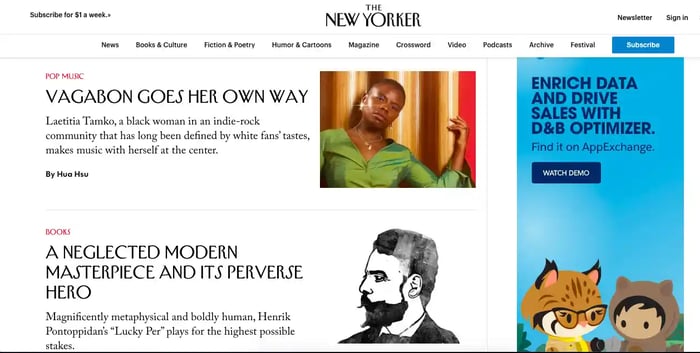
This display ad on the sidebar of The New Yorker's website is for AppExchange, a sales optimization tool. The programmatic ad software identified that a large portion of The New Yorker's audience work on weekdays between 9 to 5 and are interested in that type of software.
Display ads facilitate the purchase and selling of ad slots. Display networks make a profit from clicks or impressions.
Video Ads
Video ads are super versatile, and they're also how I got the Nissan ad while watching Hulu. Video ads can play in-display, pre-roll, mid-roll, post-roll, in-stream, and out-stream.
In-Display Video Ads
In-display ads show up as recommended ads on video sharing sites like YouTube. They're clearly labeled as an ad in recommended sections as well.
Pre-Roll, Mid-Roll, and Post-Roll Video Ads
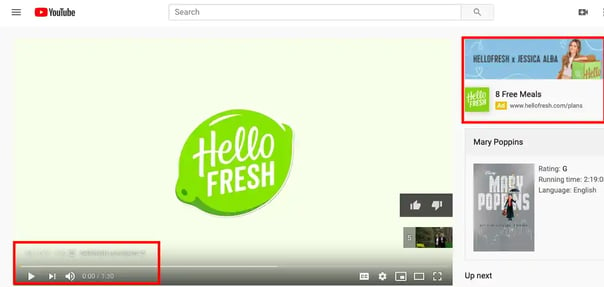
This webpage on YouTube has an in-display ad in the sidebar as well as what's known as a pre-roll ad. Pre-roll ads are the ones you see before a video begins, while mid-roll is in the middle, like a television commercial. Post-roll ads play after the video ends.
In-Stream and Out-Stream Video Ads
In-stream ads are displayed within a video, like when a YouTube influencer recognizes the sponsor for their video. But out-stream ads are a little different. They're displayed on webpages, typically in between articles and videos.
Social Ads
Social ads are advertisements you see on any given social media platform. Social media sites collect user data to create personalized experiences. The data collected will determine who will see the ads, what format users will see it in, and when the ad will be displayed.
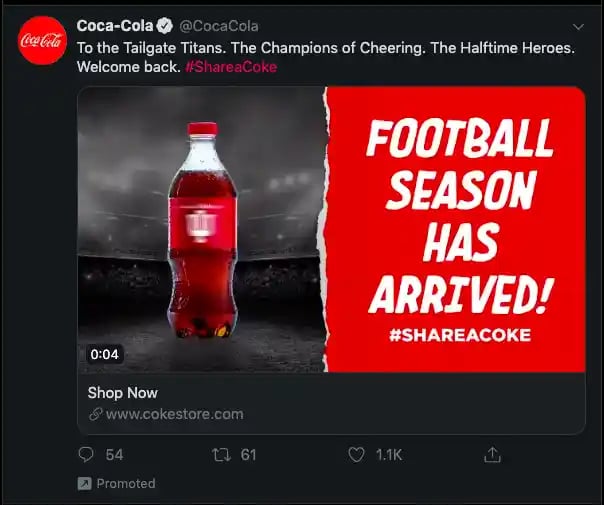
Check out this Coke ad on my Twitter timeline. I'm not a soda fan, but I am a huge football fan (#MonstersoftheMidway). The programmatic ad software probably chose this ad due to my internet history surrounding football.
When social ads are made by influencers, the process is identical. Programmatic influencer marketing platforms identify influencers, contact them on your behalf, and automate the campaign from there.
Audio Ads
Have you ever listened to any podcast on a network, ever? If so, how many Blue Apron ads have you listened to? This is thanks to programmatic audio advertising.
My favorite networks, Parcast and Slate, often choose ads centered around home life and personal care, like meal kits and hair dye. Spotify is also a channel for audio ads, especially on their Freemium version.
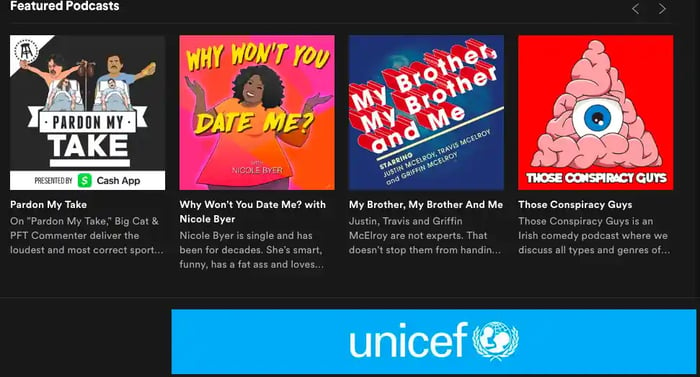
Though you can't hear this Unicef ad, this is a good example of a native ad on the Spotify Podcast webpage. What is a native ad, you ask?
Native Ads
Native ads differ from your standard display ads. While display ads are limited to three places, native ads can appear literally anywhere else. Very handy when you want an ad placed in the middle of a webpage.
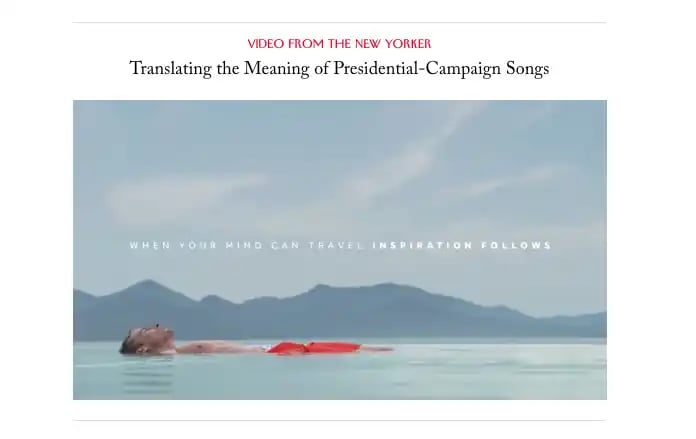
This is a native ad from The New Yorker that was displayed about ¾ of the way into my webpage. Native ads are a good idea if you want to catch a reader's attention in a way that is more direct than a regular display ad.
TV Ads
You’re likely already familiar with TV ads — 30- to 60-second videos that run during commercial breaks. Most, if not all, TV ads are programmatic.
Take, for example, the following Wayfair ad I ran into while watching Discovery Life.
TV ads have the great benefit of having a wide reach while also commanding viewers' attention for the amount of time the ad is on the screen.
Print Ads
Print ads are another type of programmatic ad you’ve likely run into. Print magazines and newspapers sign up on Supply-Side Platforms to sell ad space on their publications.
For example, Toyota bought a full-page ad on the SEMA News magazine, advertising its Supra model.

Because print magazines cater to a highly specific audience, print programmatic ads offer the great benefit of targeting bottom-of-funnel buyers.
How can you start programmatic advertising? Below, I walk you through the best programmatic ad companies (or Demand-Side Platforms) you can use to jumpstart a campaign.
Programmatic Ad Companies
To start a programmatic ad campaign on your own, you’ll need to choose a Demand Side Platform, a self-serve software that will allow you to run programmatic ad campaigns. These are also called programmatic ad platforms or programmatic ad softwares.
The programmatic ad companies below offer the best self-serve DSPs.
1. mediasmart
mediasmart is a “self-serve programmatic ad platform” that allows you to launch both localized and widespread programmatic ad campaigns. Using mediasmart’s DSP, you can advertise on mobile apps, TV stations, podcasts, and other websites.
2. AdRoll
AdRoll’s advertising platform is another DSP that allows you to run programmatic display ads. With this platform, you have access to a handy dashboard where you can set up programmatic campaigns. AdRoll gives you access to 200+ premium ad networks and allows you to retarget campaigns as needed.
3. Smadex
Smadex’s Demand-Side Platform allows you to connect with premium mobile publishers while focusing on mobile-first usability and reach. Advertising formats include mobile banners, native ads, phone video ads, and in-app playable ads.
4. TheTradeDesk
TheTradeDesk is a media buying platform with a built-in functionality for launching cross-device programmatic ads. TheTradeDesk’s DSP offers standard targeting and geofencing capabilities, while allowing you to advertise on mediums such as TV, online video, mobile apps, and podcasts. Its most notable feature is its Koa™ AI, which optimizes your ads as they run.
5. Bidease
Bidease is a DSP that focuses on mobile ads, giving you access to “the entire mobile ecosystem through the world’s most popular mobile publishers and exchanges.” As a mobile DSP, Bidease offers a dynamic optimization option that helps you design ads for every screen size, resolution, and operating system.
6. Choozle
Choozle is a major programmatic ad company whose DSP gives you access to 98 percent of ad spaces available online. You can target audiences based on a diverse array of parameters, such as IP addresses, purchase history, psychographic information, and geolocation.
Programmatic Ad Company vs Programmatic Ad Agency
Programmatic ad companies create and offer DSPs in the same way that Internet companies provide WiFi. This is a self-serve option.
A programmatic ad agency will typically use a DSP on your behalf to deliver targeted, effective results on your programmatic ad campaigns.
Whether you choose to sign up on a DSP or hire a programmatic ad agency will depend on your budget and other factors.
Looking for inspiration? Not sure what programmatic advertising could look like? Check out the best programmatic advertising examples I’ve seen recently.
Programmatic Advertising Examples
- Amazon
- LendingTree
- QuickenLoans
- Geico Insurance
- Grammarly
- Adobe
- Zenni Optical
1. Amazon
Amazon is one of the biggest programmatic advertisers with over $100 million USD in programmatic ad spend. You’ll see Amazon ads everywhere, including Snapchat and USA Network.


2. LendingTree
LendingTree is another major programmatic advertiser, spending, like Amazon, more than a $100 million in programmatic ad campaigns.
3. QuickenLoans
If you’ve ever been near a TV or computer, you’ve seen an ad for QuickenLoans. This programmatic ad giant runs ads on social networks, TV stations, and websites. Take a look at two of its ads below:


4. Geico Insurance
Geico is famously known for its friendly gecko spokesanimal. You’ll see the mascot everywhere from magazines to YouTube videos, from TV channels to social media feeds — though recent programmatic ads feature people instead.

5. Grammarly
A relatively young company, Grammarly is a fairly new entrant to the programmatic ad game, spending a little under a $100 million in programmatic ad campaigns. Still, you’ll find their ads on TV channels such as USA Network and major publishers such as the New York Times.

6. Adobe
Adobe is, unsurprisingly, one of the biggest programmatic advertisers, with hundreds of ads running on premium publishers and TV stations.


7. Zenni Optical
If you’ve ever considered buying glasses, then you’ve likely run into Zenni Optical. With good reason — this brand invests in TV, social, and display advertising for their programmatic ad campaigns.


What does programmatic advertising mean for you? It's a great automated tool to maximize your ad spending and see the results in real-time. You can also see these ads at work by visiting any of your favorite websites right now.
Run Programmatic Ads for a Greater ROI
As a marketer, you want to maximize sales from your campaigns as much as possible, and programmatic ads can be a huge asset. I may not be thinking about buying a new car while watching Kids Baking Championship, but some are — and that's the benefit.
Editor's note: This post was originally published in October 2019 and has been updated for comprehensiveness.






